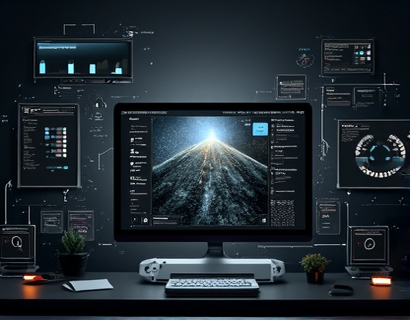Real-Time Government Data: Transforming Civic Engagement with Open Access and Accountability
The advent of real-time government data has ushered in a new era of civic engagement, one where transparency and accountability are not just ideals but tangible realities. This transformation is rooted in the principles of open data, which advocate for the free and unrestricted access to information collected and generated by government entities. The impact of this shift is profound, redefining the relationship between citizens and their government, and fostering a more informed and participatory democracy.
At the core of this revolution is the recognition that government data, by its nature, belongs to the public. Traditional barriers to access, such as proprietary systems and bureaucratic red tape, are being dismantled through the adoption of open data policies. These policies mandate that a wide range of data, from budget allocations to environmental monitoring, be made available in accessible formats. This openness not only empowers citizens with the information they need to make informed decisions but also holds government officials accountable for their actions and policies.
Enhancing Transparency Through Real-Time Data
Real-time data provides an unprecedented level of transparency, allowing citizens to observe government operations as they unfold. This immediacy is crucial in building trust between the governed and those who govern. For instance, real-time updates on public spending can help citizens track how tax dollars are being used, ensuring that funds are allocated efficiently and ethically. Similarly, live data on public services, such as traffic conditions or hospital wait times, enables citizens to make better choices and hold service providers accountable for performance.
The City of Barcelona serves as a prime example of a municipality leveraging real-time data to enhance transparency. Through its Open Data portal, residents and visitors can access a wealth of information, from public transportation schedules to energy consumption data. This openness has not only improved service delivery but has also spurred innovation, with developers creating applications that utilize this data to benefit the community.
Fostering Informed Citizen Participation
The availability of real-time government data significantly enhances citizen participation in democratic processes. Informed citizens are better equipped to engage in meaningful dialogue, advocate for their rights, and contribute to policy-making. Real-time data provides the necessary context and evidence to support informed opinions and actions. For example, real-time air quality data can mobilize communities to demand stricter environmental regulations or encourage the adoption of sustainable practices.
Moreover, real-time data facilitates grassroots movements and community initiatives. Activists and organizers can use live data to coordinate efforts, track progress, and measure the impact of their actions. This data-driven approach ensures that efforts are targeted and effective, leading to tangible improvements in community well-being. The Arab Spring, while not solely driven by data, illustrates how access to real-time information can galvanize public sentiment and drive significant social change.
Promoting Accountability and Reducing Corruption
One of the most significant benefits of real-time government data is its role in promoting accountability and reducing corruption. When government operations are transparent, there is less room for misuse of power and resources. Citizens can monitor expenditures, track project progress, and identify potential irregularities. This constant oversight acts as a deterrent against corrupt practices, as officials are aware that their actions are being watched and recorded.
The Indian government's e-Governance initiatives are a testament to this. By making procurement processes and public spending transparent, the government has reduced opportunities for corruption and increased efficiency. Citizens can now track the allocation of funds for public projects, ensuring that resources are used as intended. This level of transparency has not only improved public trust but has also led to more responsible governance.
Challenges and Solutions in Implementing Open Data
Despite the numerous benefits, the implementation of real-time government data faces several challenges. One major hurdle is the technical infrastructure required to collect, process, and disseminate data efficiently. Many governments, especially in developing regions, lack the necessary resources and expertise to build robust open data platforms. To address this, international organizations and tech-savvy NGOs can provide support and guidance, helping to establish the foundational infrastructure needed for open data initiatives.
Another challenge is ensuring data quality and accuracy. Real-time data must be reliable and up-to-date to be useful. Governments need to invest in data governance frameworks that ensure data is collected, stored, and published with high standards of quality. Regular audits and user feedback mechanisms can help maintain data integrity and build public confidence in the system.
Enhancing Civic Engagement Through Technology
Technology plays a pivotal role in bridging the gap between government and citizens. Mobile applications, web portals, and social media platforms are essential tools for disseminating real-time data and engaging the public. These platforms make information accessible to a broader audience, including those in remote or underserved areas. For instance, mobile apps that provide real-time updates on public services can empower citizens to report issues directly to the relevant authorities, fostering a sense of ownership and responsibility.
The use of data visualization tools is also crucial in making complex data understandable and actionable. Interactive maps, charts, and dashboards can help citizens grasp trends and patterns, facilitating better-informed decisions. The success of platforms like Data.gov, which offers a wide array of visualizations, demonstrates the potential of technology to enhance civic engagement.
Building a Collaborative Governance Model
The shift towards real-time government data is not just about providing information; it is about fostering a collaborative governance model where citizens are active participants. This model requires a cultural shift within government institutions, moving from a mindset of secrecy and control to one of openness and collaboration. Governments must embrace feedback from citizens and incorporate it into policy-making processes. Public consultations, crowdsourcing ideas, and participatory budgeting are examples of how this collaboration can be achieved.
The Norwegian government's use of digital platforms to involve citizens in the budgeting process is a notable example. By allowing citizens to propose and vote on budget items, the government ensures that public funds are allocated based on the priorities of the community. This approach not only increases transparency but also builds a stronger connection between citizens and their government.
Conclusion
The integration of real-time government data into civic engagement represents a significant leap forward in the evolution of democracy. By embracing open data, governments can enhance transparency, promote accountability, and foster a more informed and active citizenry. The path to a more transparent and collaborative government is clear, and the benefits are undeniable. As more regions adopt these practices, the global community moves closer to a future where governance is not just about power but about service and partnership.










































